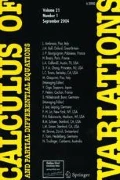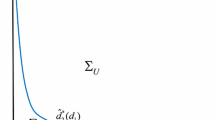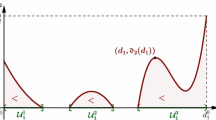Abstract
In this paper—Part III of this series of three papers, we continue to investigate the joint effects of diffusion and spatial concentration on the global dynamics of the classical Lotka–Volterra competition–diffusion system. To further illustrate the general results obtained in Part I (He and Ni in Commun Pure Appl Math 69:981–1014, 2016. doi:10.1002/cpa.21596), we have focused on the case when the two competing species have identical competition abilities and the same amount of total resources. In contrast to Part II (He and Ni in Calc Var Partial Differ Equ 2016. doi:10.1007/s00526-016-0964-0), our results here show that in case both species have spatially heterogeneous distributions of resources, the outcome of the competition is independent of initial values but depends solely on the dispersal rates, which in turn depends on the distribution profiles of the resources—thereby extending the celebrated phenomenon “slower diffuser always prevails!” Furthermore, the species with a “sharper” spatial concentration in its distribution of resources seems to have the edge of competition advantage. Limiting behaviors of the globally asymptotically stable steady states are also obtained under various circumstances in terms of dispersal rates.



Similar content being viewed by others
References
Brown, K.J., Lin, S.S.: On the existence of positive eigenfunctions for an eigenvalue problem with indefinite weight function. J. Math. Anal. Appl. 75, 112–120 (1980)
Cantrell, R.S., Cosner, C.: On the effects of spatial heterogeneity on the persistence of interacting species. J. Math. Biol. 37, 103–145 (1998)
Cantrell, R.S., Cosner, C.: Spatial Ecology via Reaction–Diffusion Equations, Series in Mathematical and Computational Biology. Wiley, Chichester (2003)
Dockery, J., Hutson, V., Mischaikow, K., Pernarowski, M.: The evolution of slow dispersal rates: a reaction–diffusion model. J. Math. Biol. 37, 61–83 (1998)
Gilbarg, D., Trudinger, N.S.: Elliptic Partial Differential Equations of Second Order, Grundlehren der Mathematicschen Wissenschaften, vol. 224. Springer, Berlin (1983)
He, X., Ni, W.-M.: The effects of diffusion and spatial variation in Lotka–Volterra competition–diffusion system, I: heterogeneity vs. homogeneity. J. Differ. Equ. 254, 528–546 (2013)
He, X., Ni, W.-M.: The effects of diffusion and spatial variation in Lotka–Volterra competition–diffusion system, II: the general case. J. Differ. Equ. 254, 4088–4108 (2013)
He, X., Ni, W.-M.: Global dynamics of the Lotka–Volterra competition–diffusion system: diffusion and spatial heterogeneity, I. Commun. Pure Appl. Math. 69, 981–1014 (2016). doi:10.1002/cpa.21596
He, X., Ni, W.-M.: Global dynamics of the Lotka–Volterra competition–diffusion system with equal amount of total resources, II. Calc. Var. Partial Differ. Equ. (2016). doi:10.1007/s00526-016-0964-0
Holmes, E.E., Lewis, M.A., Banks, J.E., Veit, R.R.: Partial differential equations in ecology: spatial interactions and population dynamics. Ecology 75, 17–29 (1994)
Hutson, V., López-Gómez, J., Mischaikow, K., Vickers, G.: Limit behavior for a competing species problem with diffusion. In: Dynamical Systems and Applications, World Scientific Series in Applicable Analysis, vol. 4, World Scientific Publishing, River Edge, pp. 343–358 (1995)
Hutson, V., Lou, Y., Mischaikow, K.: Spatial heterogeneity of resources versus Lotka–Volterra dynamics. J. Differ. Equ. 185, 97–136 (2002)
Hutson, V., Lou, Y., Mischaikow, K.: Convergence in competition models with small diffusion coefficients. J. Differ. Equ. 211, 135–161 (2005)
Lam, K.-Y., Ni, W.-M.: Uniqueness and complete dynamics in the heterogeneous competition–diffusion systems. SIAM J. Appl. Math. 72, 1695–1712 (2012)
Lou, Y.: On the effects of migration and spatial heterogeneity on single and multiple species. J. Differ. Equ. 223, 400–426 (2006)
Lou, Y.: Some challenging mathematical problems in evolution of dispersal and population dynamics. In: Tutorials in Mathematical Biosciences IV, Lecture Notes in Mathematics 1922, pp. 171–205, Springer, Berlin (2008)
Ni, W.-M.: The mathematics of diffusion. In: CBMS-NSF Regional Conference Series in Applied Mathematics, vol. 82, SIAM, Philadelphia (2011)
Sattinger, D.H.: Monotone methods in nonlinear elliptic and parabolic boundary value problems. Indiana Univ. Math. J. 21, 979–1000 (1972)
Senn, S., Hess, P.: On positive solutions of a linear elliptic eigenvalue problem with Neumann boundary conditions. Math. Ann. 258, 459–470 (1982)
Shigesada, N., Kawasaki, K.: Biological Invasions: Theory and Practice, Oxford Series in Ecology and Evolution. Oxford University Press, Oxford (1997)
Author information
Authors and Affiliations
Corresponding author
Additional information
Communicated by P. Rabinowitz.
X. He is supported in part by Postdoctoral Science Foundation of China (No. 2015M580304) and NSFC (11601155).
W.-M. Ni is supported in part by NSF and NSFC, 111 Project and Recruitment Program of Global Experts in China.
Rights and permissions
About this article
Cite this article
He, X., Ni, WM. Global dynamics of the Lotka–Volterra competition–diffusion system with equal amount of total resources, III. Calc. Var. 56, 132 (2017). https://doi.org/10.1007/s00526-017-1234-5
Received:
Accepted:
Published:
DOI: https://doi.org/10.1007/s00526-017-1234-5




